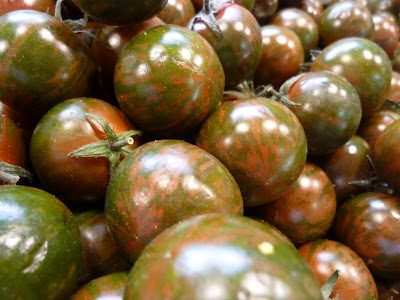
I've been making a lot of ice cream recently and experimenting with different flavors. The best one I've made so far is zucchini ice cream. It's also the ice cream that everyone, across the board, loves. As long as I don't tell them it's made from zucchini. I really get a kick out of making a great ice cream from a vegetable.
The other thing I love about this ice cream is that it's another way to use up all the zucchini in my garden. Of course zucchini are not a weed, but they act like they are. Even if I miss a few days of gathering zucchini, when I finally make it into the garden I find I have enough zucchini gathered to feed everyone on my street. There are also inevitably a few "attack" zucchini in the garden: so large you can hardly lift them. I think they hide from me until they reach that size. Of course it's not true but it does seem so given how rapidly they grow. I find myself talking to the zucchini, asking them where they came from in such short time. Enough about that because already my daughter finds it odd that I personify the vegetables growing in my garden.
This is what I gather in my basket every day:

I explained my approach to ice cream in past posts: I'm trying to reproduce everything sweet that I love in ice cream form. In this case it's zucchini bread. I've looked at each of its ingredients, and selected those that make it uniquely zucchini bread. The zucchini are grated (better if it's everything but the very center of the vegetable where the seeds are).

The essential flavors that come through in zucchini bread are sugar and cinnamon, and sometimes walnuts. So that's what I used for the ice cream, to keep it simple yet delicious.
Ingredients:
- Milk, whole - 1 1/4 cup (200 ml)
- Cream - 1 1/2 cups (355 ml)
- Vanilla extract - 1 tsp (5 ml)
- Sugar - 1/2 cup (100 grams)
- Cinnamon - 1 tsp
- Salt - 1/4 tsp
- Zucchini, grated (all except the seedy center) - 1 1/4 cup (190 grams)
- Walnuts, finely chopped (optional) - 2/3 cup (50 grams)
- Place all the ingredients (except the walnuts) in a saucepan and simmer until the zucchini is just tender but not mushy.
- Place the pan in an ice water bath and cool completely.
- Add the walnuts if desired.
- Follow the manufacturer's instructions for your ice cream maker or:
- Pour the mixture into a flat metal baking pan and freeze.
- Once frozen the ice cream can be served, or stored for future use:
- Transfer the ice cream into an airtight container and return to the freezer.



























